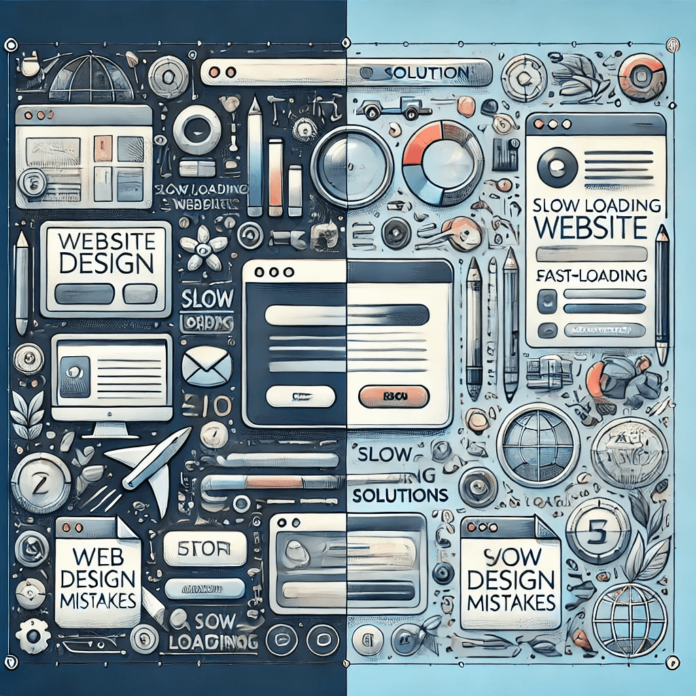Introduction
- 1. Slow Loading Speeds
- 2. Poor Mobile Responsiveness
- 3. Overcrowded or Cluttered Layouts
- 4. Confusing Navigation
- 5. Weak or Missing CTAs
- 6. Poor Use of Color and Contrast
- 7. Ignoring SEO Best Practices
- 8. Low-quality or Irrelevant Visuals
- 9. Neglecting Accessibility
- 10. Lack of Analytics and Testing
- Top Website Design Mistakes to Avoid for Better Performance
- Conclusion
- Questions
Website design mistakes can hurt your online presence, driving away potential customers and reducing conversions. Avoiding bad website design practices is essential for creating a user-friendly experience that keeps visitors engaged. From slow loading speeds to poor navigation, common web design errors can significantly impact usability and SEO performance. A well-designed website is essential for capturing attention, retaining visitors, and driving conversions. However, even the most visually appealing websites can fail if they overlook crucial usability and functionality aspects.
1. Slow Loading Speeds
Visitors expect websites to load within seconds. A slow site not only frustrates users but also negatively affects your search engine rankings.
How to Fix It:
- Compress images and use formats like WebP for faster loading.
- Implement caching to store frequently accessed resources.
- Invest in a high-performance hosting provider.
2. Poor Mobile Responsiveness
With the majority of web traffic coming from mobile devices, failing to provide a responsive design means alienating a large portion of your audience.
How to Fix It:
- Use responsive frameworks like Bootstrap.
- Ensure seamless performance by testing your website across various devices to guarantee compatibility and a consistent user experience
- Simplify navigation and use touch-friendly buttons.
3. Overcrowded or Cluttered Layouts
A cluttered layout can distract and overwhelm users, hindering their ability to engage with key messages or take desired actions effectively.
How to Fix It:
- Prioritize content using a clear hierarchy.
- Leverage white space strategically to enhance visual balance, guide user focus, and improve overall readability on your website.
- Limit the number of fonts and colors to maintain consistency.
4. Confusing Navigation
Poor navigation frustrates users and increases bounce rates. When users struggle to locate the information they need, they’re likely to leave your site, resulting in lost engagement and potential conversions.
How to Fix It:
- Simplify menus with clear labels.
- Include a search bar for quick access.
- Use breadcrumbs to guide users through your site.
5. Weak or Missing CTAs
Call-to-action buttons are crucial for guiding users toward desired actions like signing up or making a purchase.
How to Fix It:
- Encourage user engagement with clear, action-driven phrases like ‘Get Started,’ ‘Buy Now,’ or ‘Learn More’ to guide visitors toward taking action.
- Place CTAs prominently above the fold and on key pages.
- Ensure buttons are visually distinct with contrasting colors.
6. Poor Use of Color and Contrast
Poor color selection can hinder readability and create a visually unappealing website, discouraging user engagement and trust.
How to Fix It:
- Craft visually appealing designs by leveraging tools like Adobe Color to build cohesive and harmonious color palettes for your website.
- Test color contrast for readability, especially for text and backgrounds.
- Stay consistent with your brand’s color scheme.
7. Ignoring SEO Best Practices
A visually appealing website is useless if users can’t find it. Overlooking SEO can cost you valuable organic traffic, reducing your website’s visibility and potential to attract new visitors.
How to Fix It:
- Boost your website’s visibility by optimizing meta titles, descriptions, and headings with targeted and relevant keywords.
- Ensure your site is fast and mobile-friendly.
- Use descriptive alt tags for images.
8. Low-quality or Irrelevant Visuals
Poor-quality visuals harm your site’s credibility and fail to engage users.
How to Fix It:
- Invest in high-resolution images and professional photography.
- Use relevant visuals that align with your content.
- Optimize image file sizes for faster load times.
9. Neglecting Accessibility
An inaccessible website not only alienates users with disabilities but also risks non-compliance with accessibility laws, potentially leading to legal challenges.
How to Fix It:
- Add alt text to images for screen readers.
- Ensure keyboard navigation for users who can’t use a mouse.
- Follow ADA guidelines for web accessibility compliance.
10. Lack of Analytics and Testing
Without analytics, you can’t measure your website’s performance or understand user behavior.
How to Fix It:
- Conduct A/B testing on layouts and CTAs to identify what works best.
- Use heatmaps to observe user interaction patterns.
Top Website Design Mistakes to Avoid for Better Performance

Website design mistakes can undermine your efforts to attract and retain visitors, leading to poor user engagement and missed business opportunities.
Common Website Design Mistakes to Avoid:
- Slow Loading Speeds: Visitors expect websites to load within seconds. Slow sites increase bounce rates and hurt SEO.
- Solution: Enhance website performance by optimizing images, selecting a dependable hosting provider, and utilizing caching to improve load times.
- Cluttered Layouts: Overcrowded pages can confuse users and make it difficult to focus on key elements.
- Solution: Use white space effectively and prioritize content with a clear hierarchy.
- Weak CTAs: Vague or hidden call-to-action buttons reduce conversions.
- Solution: Use bold, actionable CTAs like “Shop Now” or “Sign Up Today” in prominent locations.
Conclusion
Avoiding common website design mistakes is essential for creating a site that attracts, engages, and converts users. By addressing issues like loading speeds, navigation, and accessibility, you can enhance user experience and achieve your business goals. Regularly auditing your site and staying updated on design best practices will ensure your website remains a powerful tool for success.
Avoiding website design mistakes is crucial for creating a site that not only attracts visitors but also keeps them engaged and drives conversions. From optimizing load speeds and navigation to prioritizing mobile responsiveness and SEO best practices, addressing common web design errors ensures your site performs at its best. Regularly audit your website and adapt to evolving trends to maintain a competitive edge.
Questions
1. How do website design mistakes impact user experience?
Website design mistakes, such as slow load speeds or cluttered layouts, frustrate users and make it difficult to find information, leading to higher bounce rates and lower engagement.
2. What tools can help identify and fix website design errors?
Tools like Google PageSpeed Insights, Hotjar, and SEMrush can identify issues like slow load times, poor navigation, and SEO errors.
3. How often should I review my website design for mistakes?
You should review your website at least quarterly or whenever there’s a significant update in design trends, SEO algorithms, or your business goals. Regular audits help ensure optimal performance.














